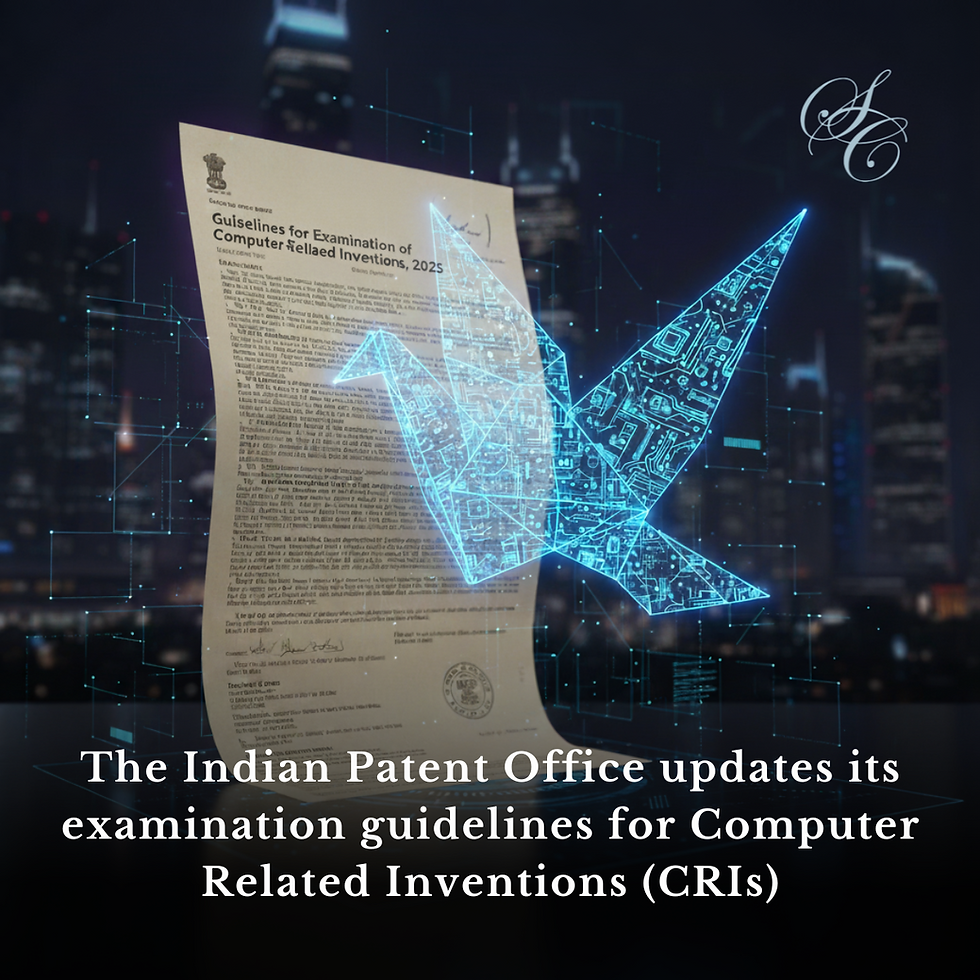Can You Trademark a Scent or Motion? All About Motion and Smell Marks
- SC IP
- Jun 13
- 5 min read

With evolving market trends and intensifying economic competition, businesses and brands are constantly seeking new ways to stand out. As a result, non-conventional trademarks are gaining traction globally.
Non-conventional trademark can be defined as an umbrella term that encompasses a wide array of marks, such as, sound mark, color mark, smell mark, motion mark, etc. These marks, though powerful in capturing consumer attention, often challenge traditional legal frameworks. This write-up specifically focuses on motion marks and smell marks, aiming to analyze the jurisprudential gaps in India when compared to other jurisdictions.
Legal Requirements for Trademarks in India
To qualify as a trademark under Section 2(1)(zb) of the Trade Marks Act, 1999, a mark must:
1. Be capable of being graphically represented, and
2. Distinguish the goods/services of one party from another.
As Rule 2(1)(k) of the Trade Marks Rules, 2017 (“TM Rules”) “graphical representation means the representation of a trademark for goods or services represented or capable of being represented in paper form and includes representation in digitized form”. The major hurdle to the registrability of unconventional trademarks in India, lies in fulfilling the eligibility criteria itself.
Motion Marks
Like any other unconventional trademarks, motion marks act as a distinctive source identifier because of their dynamic nature. Simply put, motion marks can be understood as a cumulative depiction of images or clips presented in a distinguished motion or movement.
The first motion mark to be accepted in India was the Nokia Corporations’ famous mark depicting two connecting hands. Interestingly, despite the animated nature of the mark, it was accepted by the Trade Marks Registry (“Registry”) as a device mark. Subsequently, TM Rules broadened the scope of graphical representation to the above-mentioned. Furthermore, in 2019, Toshiba Corporation’s application for a motion mark was objected by the Registry on the ground that “motion marks are not accepted in India”. However, pursuant to Toshiba’s submissions regarding the distinctiveness of the mark and its compliance with the requirement of graphical representation, the mark was ultimately accepted by the Registry as a ‘motion mark’.
When looked at from a global standpoint, the issue of graphical representation primarily, does not become a hurdle in the registration of a motion mark. For instance, in the US, an application for a motion mark requires a specimen, which must be an electronic file, that depicts the motion sufficiently to show how the mark is used for the relevant goods/ services.
Apart from the criteria of graphical representation and distinctiveness, a motion mark must also be non-functional. This requirement emanates from the fundamental principle that a trade mark must serve to indicate the source of origin of the goods and services and must not grant exclusive rights to a single proprietor over a functional or utilitarian aspect of a product. Accordingly, a mark, wherein the motion itself performs a utilitarian function, cannot be granted protection as it would go against the principle of fair competition and public interest.
It is interesting to note that while several jurisdictions, including the US, have inclusive eligibility criteria as regards motion marks, a majority of the motion mark applications encounter refusals mainly because of their failure to function as a source identifier. For example, in 2024, EUIPO rejected an application filed by KCT GmbH & Co. KG, for a motion mark showing the opening and closing of a window (click here to see the mark). This decision was further upheld by the Board of Appeal, on the grounds that the mark showed a functional process and lacked distinctiveness.
Smell Marks
As the name suggests, smell marks can be defined as a distinctive type of smell which acts as a source identifier for a particular good/service and serves to distinguish its good/service from those of others. One of the major hurdles in the registration of a smell mark lies in its intangible nature and lack of any subjective criteria to examine its distinctiveness.
The legal challenge pertaining to the registration of a smell mark surfaced in India, when Sumitomo Rubber Industries Limited, a global tyre and rubber company based in Japan, in 2023, filed an application at the Registry seeking protection for an olfactory smell of roses on and in relation to tyres.
As predicted, the Registry objected to the application stating that there is no separate category for filing of smell marks in India. Further, the Registry also pointed out that a smell mark fails to fulfill the criteria of graphical representation and there is no possible way to examine distinctiveness of a smell.
Interestingly, in its response to the examination report, the applicant has relied on the progressive approach taken by several foreign jurisdictions while interpreting the term ‘graphical representation’. Various jurisdictions, including Australia and United Kingdom (prior to 2018 amendment which removed the requirement of graphical representation) includes the criterion of graphical representation, however, these countries, at the same time, interpret graphical representation as visual representation by means of images, lines or characters. In fact, the applicant has, in the instant case, argued that since the smell of roses has no variation and is well-known to the members of public, “the use of the descriptive word for the said smell is good enough as their representation”
Reliance was also placed on the seven-fold test introduced by the European Court of Justice in the case of Siekmann v. German Patent and Trademark Office[1], where the court held that for a scent to qualify for registration, it should be capable of being represented graphically, and that the representation must be clear, precise, self-contained, easily accessible intelligible, durable and objective.
It is pertinent to note that while the Indian IP office is yet to determine the standards to examine olfactory marks, the legal development in this regard is not as recent as one might think. For instance, in a 1999 case of Vennootschap Onder Firma Senta Aromatic Marketing v. Markgraaf B.V, the Netherlands court recognized the smell of fresh cut grass in respect to tennis balls in Class 28.
The Registry is yet to arrive at a decision in this case. This much awaited decision of the Registry would play a pivotal role in shaping the future of smell-marks in India.
While it may be argued that aligning India’s intellectual property framework with evolving global standards is long overdue, particularly given the interdependent nature of global markets and economies shaped by rapid globalization, it is essential that any such transition be undertaken with careful deliberation. Recent developments suggest that India is gradually moving towards the recognition of non-traditional marks, such as smell and motion marks, indicating a shift towards harmonization with international trademark practices. However, it remains crucial to not only upgrade the existing system but also to strike a careful balance between facilitating innovation and ensuring the effectiveness of trademark protection mechanisms in India.
[1] C-273/00




Comments